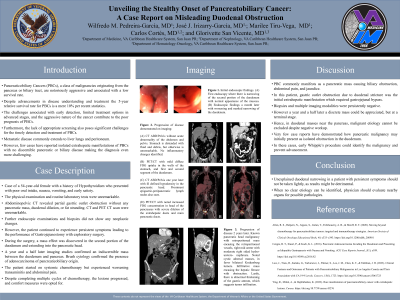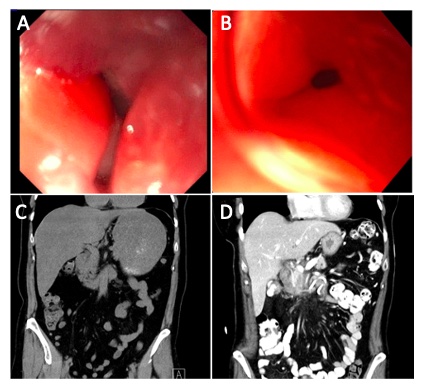Sunday Poster Session
Category: Biliary/Pancreas
P0112 - Unveiling the Stealthy Onset of Pancreatobiliary Cancer: A Case Report on Misleading Duodenal Obstruction
Sunday, October 27, 2024
3:30 PM - 7:00 PM ET
Location: Exhibit Hall E

Has Audio

Marilee Tiru-Vega, MD
VA Caribbean Healthcare System
San Juan, PR
Presenting Author(s)
Wilfredo Pedreira-Garcia, MD1, Jose Irizarry-Garcia, MD2, Marilee Tirú-Vega, MD1, Carlos Cortes-Sanchez, MD1, Glorivette San Vicente, MD1
1VA Caribbean Healthcare System, San Juan, Puerto Rico; 2VA Caribbean Healthcare System, Guaynabo, Puerto Rico
Introduction: Pancreaticobiliary Cancers (PBCs), a class of malignancies originating from the pancreas or biliary tract, are notoriously aggressive and associated with a low survival rate. The challenges associated with early detection, limited treatment options, and the aggressive nature of the cancer contribute to their poor prognosis. Few cases have reported isolated extrahepatic manifestations of PBCs with no discernible pancreatic or biliary disease making the diagnosis even more challenging. In this context, we present a case of a female with no identifiable pancreatic or biliary tract malignancy who presented with signs of duodenal obstruction which later was found to be the initial extrahepatic manifestation of PBC.
Case Description/Methods: A 54-year-old female with a history of hypothyroidism, presented with poor oral intake, vomiting, and early satiety. Abdominopelvic CT revealed partial gastric outlet obstruction without any pancreatic mass, duodenal dilation, or fat stranding. Further endoscopic examinations and biopsies did not show any neoplastic changes. The patient continued to experience persistent symptoms, leading to the performance of Gastrojejunostomy with exploratory surgery where a mass effect was discovered in the second portion of the duodenum, extending into the pancreatic head. One year later imaging studies confirmed an indiscernible mass between the duodenum and pancreas. Brush cytology confirmed the presence of adenocarcinoma of pancreaticobiliary origin. Despite completing multiple cycles of chemotherapy, the lesions progressed, and comfort measures were opted for.
Discussion: PBC commonly manifests as a pancreatic mass causing biliary obstruction, abdominal pain, and jaundice. In these cases, pancreatic masses may obstruct the duodenum and common bile duct. In this patient, gastric outlet obstruction due to duodenal stricture was the initial extrahepatic manifestation which required gastrojejunal bypass. Biopsies and multiple imaging modalities were persistently negative. However, a year later a discrete mass could be appreciated at a terminal stage. Hence, in duodenal masses near the pancreas, malignant etiology cannot be excluded. Very few case reports have demonstrated how pancreatic malignancy may initially present as isolated obstruction in the duodenum. In these cases, early Whipple’s procedure could identify the malignancy and prevent advancement. This case demonstrates that pancreatobiliary malignancies can be occult, and rapid detection can save lives.

Disclosures:
Wilfredo Pedreira-Garcia, MD1, Jose Irizarry-Garcia, MD2, Marilee Tirú-Vega, MD1, Carlos Cortes-Sanchez, MD1, Glorivette San Vicente, MD1. P0112 - Unveiling the Stealthy Onset of Pancreatobiliary Cancer: A Case Report on Misleading Duodenal Obstruction, ACG 2024 Annual Scientific Meeting Abstracts. Philadelphia, PA: American College of Gastroenterology.
1VA Caribbean Healthcare System, San Juan, Puerto Rico; 2VA Caribbean Healthcare System, Guaynabo, Puerto Rico
Introduction: Pancreaticobiliary Cancers (PBCs), a class of malignancies originating from the pancreas or biliary tract, are notoriously aggressive and associated with a low survival rate. The challenges associated with early detection, limited treatment options, and the aggressive nature of the cancer contribute to their poor prognosis. Few cases have reported isolated extrahepatic manifestations of PBCs with no discernible pancreatic or biliary disease making the diagnosis even more challenging. In this context, we present a case of a female with no identifiable pancreatic or biliary tract malignancy who presented with signs of duodenal obstruction which later was found to be the initial extrahepatic manifestation of PBC.
Case Description/Methods: A 54-year-old female with a history of hypothyroidism, presented with poor oral intake, vomiting, and early satiety. Abdominopelvic CT revealed partial gastric outlet obstruction without any pancreatic mass, duodenal dilation, or fat stranding. Further endoscopic examinations and biopsies did not show any neoplastic changes. The patient continued to experience persistent symptoms, leading to the performance of Gastrojejunostomy with exploratory surgery where a mass effect was discovered in the second portion of the duodenum, extending into the pancreatic head. One year later imaging studies confirmed an indiscernible mass between the duodenum and pancreas. Brush cytology confirmed the presence of adenocarcinoma of pancreaticobiliary origin. Despite completing multiple cycles of chemotherapy, the lesions progressed, and comfort measures were opted for.
Discussion: PBC commonly manifests as a pancreatic mass causing biliary obstruction, abdominal pain, and jaundice. In these cases, pancreatic masses may obstruct the duodenum and common bile duct. In this patient, gastric outlet obstruction due to duodenal stricture was the initial extrahepatic manifestation which required gastrojejunal bypass. Biopsies and multiple imaging modalities were persistently negative. However, a year later a discrete mass could be appreciated at a terminal stage. Hence, in duodenal masses near the pancreas, malignant etiology cannot be excluded. Very few case reports have demonstrated how pancreatic malignancy may initially present as isolated obstruction in the duodenum. In these cases, early Whipple’s procedure could identify the malignancy and prevent advancement. This case demonstrates that pancreatobiliary malignancies can be occult, and rapid detection can save lives.

Figure: Figure 1: (A) First endoscopy where there is narrowing of the second portion of the duodenum with normal appearance of the mucosa. (B) Endoscopic findings a month later with worsening and marked narrowing of the duodenum. (C) Initial abdominopelvic CT without acute abnormality of the abdomen and pelvis. Stomach is distended with fluid and debris, but otherwise is unremarkable. No inflammatory changes identified. (D) Abdominopelvic CT one year later with ill defined hypodensity in the pancreatic head. Prominent epigastric-peripancreatic lymph nodes also seen.
Disclosures:
Wilfredo Pedreira-Garcia indicated no relevant financial relationships.
Jose Irizarry-Garcia indicated no relevant financial relationships.
Marilee Tirú-Vega indicated no relevant financial relationships.
Carlos Cortes-Sanchez indicated no relevant financial relationships.
Glorivette San Vicente indicated no relevant financial relationships.
Wilfredo Pedreira-Garcia, MD1, Jose Irizarry-Garcia, MD2, Marilee Tirú-Vega, MD1, Carlos Cortes-Sanchez, MD1, Glorivette San Vicente, MD1. P0112 - Unveiling the Stealthy Onset of Pancreatobiliary Cancer: A Case Report on Misleading Duodenal Obstruction, ACG 2024 Annual Scientific Meeting Abstracts. Philadelphia, PA: American College of Gastroenterology.
